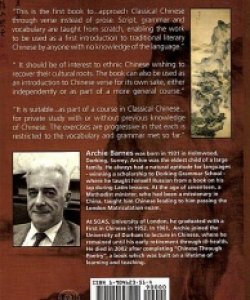Chinese Through Poetry: An introduction to the language and imagery of traditional verse. - Archie Barnes | Work
Browse Chinese Through Poetry: An introduction to the language and imagery of traditional verse. - Archie Barnes
This is a dual-purpose text book. While the sub-title An Introduction to the Language and Imagery of Traditional Verse is a description of the main contents, the main title Chinese through Poetry needs some explanation. It indicates the original motivation behind my approach.
It is usual to approach the study of Classical Chinese first through prose and only later (if at all) through verse. I am attempting to reverse this procedure in the hope that approaching Classical Chinese through a preliminary study of verse will be more effective for several reasons. First, the student is given confidence by learning to read complete, self-contained texts with a minimum of vocabulary. Second, the contents are mainly words used in their original concrete meanings rather than in the abstract extended meanings more common in prose. Third, the vividness, colour and emotional content of the poems should assist vocabulary absorption in memorable contexts. Fourth, poetry brings us closer to the essence of the Chinese psyche than the philosophical texts traditionally used for learning Classical Chinese. It is for this reason that script, grammar and vocabulary are taught from scratch, enabling the work to be used as a first introduction to traditional literary Chinese by anyone with no knowledge of the language. The book can of course be used as an introduction to Chinese verse for its own sake, either independently or as part of a more general course.
To be more precise, this book is an introduction to the language and imagery of traditional Chinese lyrical verse, concentrating on the Tang dynasty (618–907) but ranging back to the Han (206 BC to AD 220) and forward to the Sung (960–1279) when appropriate.
The script used is the traditional one, not the simplified version. The system of transcription used is the standard pinyin. Its primary purpose is not, of course, to indicate the medieval pronunciation of the Chinese texts but to enable the reader to use the Vocabulary Index and any Chinese-English dictionaries arranged by pinyin.
References are given for all Chinese verse texts quoted. Where possible I have given a reference to The Three Hundred Tang Poems since it is often used as a source of texts for students.
Though I suppose that this course will be used mainly by students who are already familiar with at least the rudiments of modern Chinese and of the Chinese script, I have made provision for the absolute beginner with no knowledge of any kind of Chinese by including an introductory section on the Chinese writing-system. For such new-comers to Chinese I should suggest that this course be followed by a more advanced work: D. Hawkes, A Little Primer of Tu Fu, Oxford, 1967, reprinted 1987. A dictionary in traditional script will also be needed for further study, such as R. H. Mathews, A Chinese-English Dictionary..., Harvard UP, 1974.

Publishers
Authors
Plotting the Novel Robert Hale Ltd 10-05-1992 List price: £7.99 Lowest price: £92.20 Pages: 128 |
|


